
Reforestation is the natural or intentional restocking of existing forests and woodlands (forestation) that have been depleted, usually through deforestation but also after clearcutting. Two important purposes of reforestation programs are for harvesting of wood or for climate change mitigation purposes.

Logging is the process of cutting, processing, and moving trees to a location for transport. It may include skidding, on-site processing, and loading of trees or logs onto trucks or skeleton cars. In forestry, the term logging is sometimes used narrowly to describe the logistics of moving wood from the stump to somewhere outside the forest, usually a sawmill or a lumber yard. In common usage, however, the term may cover a range of forestry or silviculture activities.

Illegal logging is the harvest, transportation, purchase, or sale of timber in violation of laws. The harvesting procedure itself may be illegal, including using corrupt means to gain access to forests; extraction without permission, or from a protected area; the cutting down of protected species; or the extraction of timber in excess of agreed limits. Illegal logging is a driving force for a number of environmental issues such as deforestation, soil erosion and biodiversity loss which can drive larger-scale environmental crises such as climate change and other forms of environmental degradation.
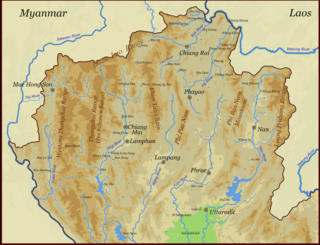
The Thai highlands or Hills of northern Thailand is a mountainous natural region in the north of Thailand. Its mountain ranges are part of the system of hills extending through Laos, Burma, and China and linking to the Himalayas, of which they may be considered foothills.
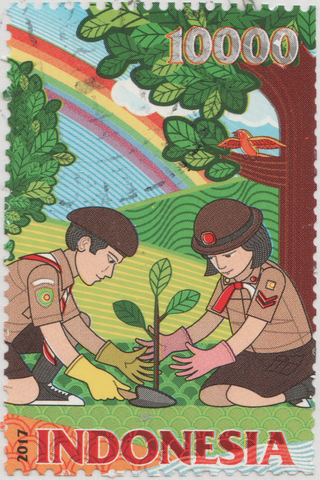
Environmental issues in Indonesia are associated with the country's high population density and rapid industrialisation, and they are often given a lower priority due to high poverty levels, and an under-resourced governance.

Deforestation in Cambodia has increased in recent years. Cambodia is one of the world's most forest endowed countries, that was not historically widely deforested. However, massive deforestation for economic development threatens its forests and ecosystems. As of 2015, the country has one of the highest rates of deforestation in the world.

Forestry in India is a significant rural industry and a major environmental resource. India is one of the ten most forest-rich countries of the world. Together, India and 9 other countries account for 67 percent of the total forest area of the world. India's forest cover grew at 0.20% annually over 1990–2000, and has grown at the rate of 0.7% per year over 2000–2010, after decades where forest degradation was a matter of serious concern.
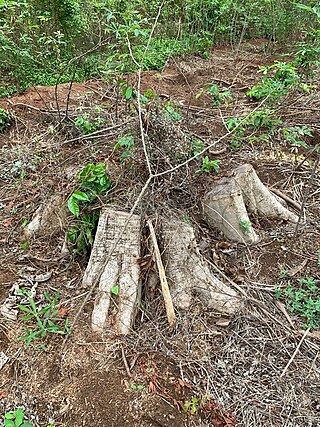
Deforestation in Nigeria refers to the extensive and rapid clearing of forests within the borders of Nigeria. This environmental issue has significant impacts on both local and global scales.
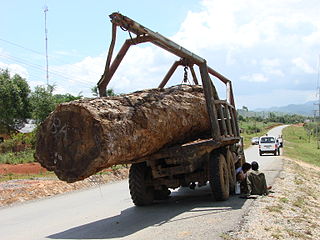
Deforestation in Laos is a major environmental concern, with Laos losing forest area to legal and illegal logging.

Deforestation is a major threat to biodiversity and ecosystems in Costa Rica. The country has a rich biodiversity with some 12,000 species of plants, 1,239 species of butterflies, 838 species of birds, 440 species of reptiles and amphibians, and 232 species of mammals, which have been under threat from the effects of deforestation. Agricultural development, cattle ranching, and logging have caused major deforestation as more land is cleared for these activities. Despite government efforts to mitigate deforestation, it continues to cause harm to the environment of Costa Rica by impacting flooding, soil erosion, desertification, and loss of biodiversity.

Rates and causes of deforestation vary from region to region around the world. In 2009, two-thirds of the world's forests were located in just 10 countries: Russia, Brazil, Canada, the United States, China, Australia, the Democratic Republic of the Congo, Indonesia, India, and Peru.

Deforestation in Indonesia involves the long-term loss of forests and foliage across much of the country; it has had massive environmental and social impacts. Indonesia is home to some of the most biologically diverse forests in the world and ranks third in number of species behind Brazil and the Democratic Republic of Congo.

Deforestation in Borneo has taken place on an industrial scale since the 1960s. Borneo, the third largest island in the world, divided between Indonesia, Malaysia and Brunei, was once covered by dense tropical and subtropical rainforests.
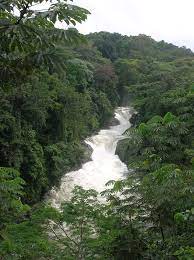
Oba Hills Forest Reserve is a reserve in Iwo, Osun State, Nigeria, that covers about 52 km2 of hilly terrain with deep gorges. Oba Hill Forest Reserve is a small enclave encompassing three hills with a wide valley running in between. A large teak plantation is there on its western side, covering about 12% of its total area beyond the hills. Only coppices are left on the over-exploited plantation. According to a UICN report from 2003, about 12% of the reserve had been planted with teak. Some chimpanzee sightings had been reported, and in 1999, a dead chimp was offered for sale in a local market. A 2009 report said that almost all of the reserve had been converted to plantations and farms, with only two gullies remaining forest-covered. It is now believed that chimpanzees are nearly extinct in the reserve.

As in other Southeast Asian countries, deforestation in the Philippines is a major environmental issue. Over the course of the 20th century, the forest cover of the country dropped from 70 percent down to 20 percent. Based on an analysis of land use pattern maps and a road map an estimated 9.8 million hectares of forests were lost in the Philippines from 1934 to 1988.

Deforestation in the Democratic Republic of the Congo (DRC) is an environmental conflict of international importance. Most of the deforestation takes place in the Congo Basin, which holds the second largest rainforest of the world after the Amazon. Roughly fifty percent of the remaining rainforest in the Congo Basin lies within the boundaries of the DRC.
Forest conservation is the practice of planning and maintaining forested areas for the benefit and sustainability of future generations. Forest conservation involves the upkeep of the natural resources within a forest that are beneficial for both humans and the ecosystem. Forests provide wildlife with a suitable habitat for living which allows the ecosystem to be biodiverse and benefit other natural processes. Forests also filter groundwater and prevent runoff keeping water safe for human consumption. There are many types of forests to consider and various techniques to preserve them. Of the types of forests in the United States, they each face specific threats. But, there are various techniques to implement that will protect and preserve them.
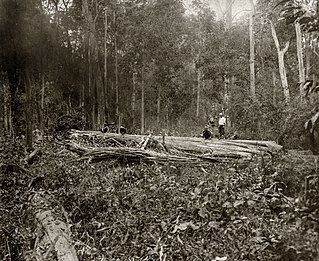
According to a report by the Food and Agriculture Organization of the United Nations, Myanmar lost 19%, or 7,445,000 hectares, of forest between 1990 and 2010. With forest covering as much as 70% of Burma at the time of independence, there were only slightly more than 48% forest cover left as of 2014. The deforestation rate of Myanmar has declined from 0.95% per year in the years 1990–2010 to about 0.3% per year and deforestation in Myanmar is now less than other countries of the region such as Indonesia or Vietnam, but still remains an important environmental issue. Three main factors contribute to continued deforestation: unsustainable and illegal logging, unresolved land rights and land disputes and extensive agricultural development.
Laos is increasingly suffering from environmental problems, with deforestation a particularly significant issue, as expanding commercial exploitation of the forests, plans for additional hydroelectric facilities, foreign demand for wild animals and nonwood forest products for food and traditional medicines, and a growing population all create increasing pressure.

Reforestation in Nigeria employs both natural and artificial methods. Reforestation involves the deliberate planting of trees and restoring forested areas that have been depleted or destroyed. It involves a planned restocking of the forest to ensure sustainable supply of timber and other forest products. Reforestation, in essence, involves replenishing forests to guarantee a consistent and sustainable supply of timber and various other forest resources. This objective can be accomplished through either natural regeneration techniques or artificial regeneration methods. Both of these approaches have been utilized in the reforestation efforts within Nigeria's forests. At the initiation of the reforestation program in Nigeria, the natural regeneration approach was chosen for two primary reasons. Firstly, it aimed to preserve the rainforest in its original state by allowing it to regenerate naturally from the existing seed bank in the soil. Secondly, and of significant importance, this method was selected due to budgetary constraints, as there were insufficient funds available to establish plantations through direct means.





















